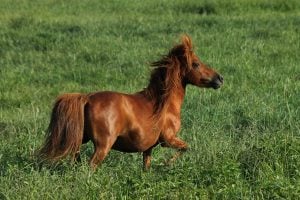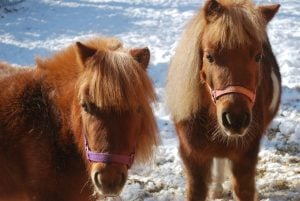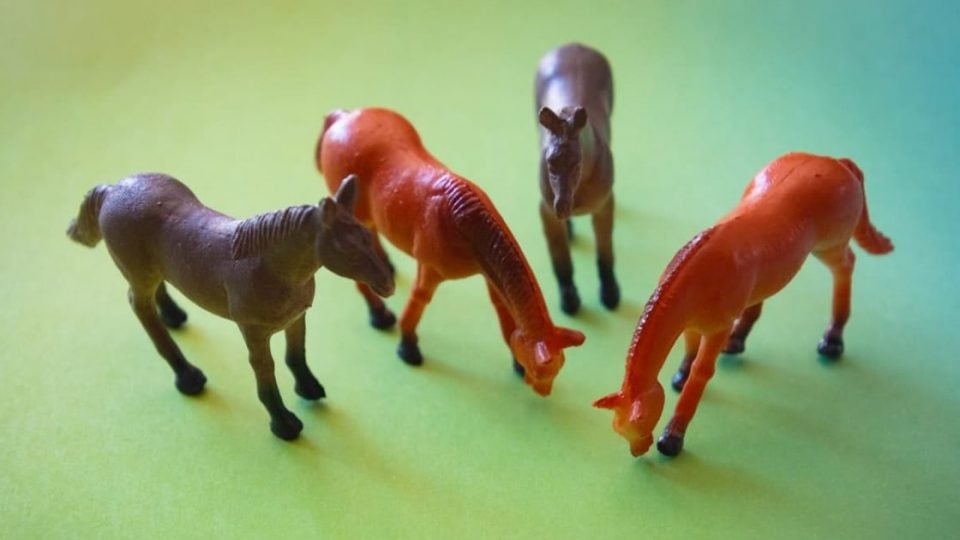- This post contains affiliate links. Read more here.
- Not a substitute for professional veterinary help.
Some say the best things come in small packages, and that goes for horses, too! But what exactly is a Miniature Horse and what does it cost to raise a Mini Horse, from money to time?
Though Miniatures can be closer in size to a large-breed dog than a full-size horse, cost and care to raise Mini Horses are quite different than for our canine pals. “Their care, management, training, and breeding is very similar to horses of all sizes and shapes,” says Kendra Gale, founder of Miniature Horsemanship based in Alberta, Canada. Gale’s been around Miniatures since age 1 and currently cares for 43 Miniature Horses; she also leads online classes on every aspect of Miniature ownership from feeding to showing.
With the help of Gale’s expertise, we walk through what makes Minis unique and the key things you need to raise a happy and healthy Mini Horse.

Mark Edwards/Pixabay
The Cost of Raising a Mini Horse: What is a Miniature Horse?
“The defining characteristic is size,” says Gale. In general, they range from 25 to 38 inches from hoof to withers (the highest part of a horse’s back). Their classification as a Mini is defined as under 34 inches or under 38 inches depending on the registry—in North America, there are two, The American Miniature Horse Association and the American Miniature Horse Registry.
Gale says that Miniatures are closely related to Shetland Ponies. In fact, horses taller than 38 inches are classified as small ponies.
Minis can have health issues specific to their breed and small stature that differ from full-size horses that their parents should be aware of. Health problems can include dental issues, deformities (such as dwarfism or a luxated patella), difficulties birthing, and issues with obesity and fat storage.
To keep your Mini healthy, it’s important to raise them according to their nutritional and environmental needs. For more on that, read on!
The Cost of Raising a Mini Horse: Is Your Lifestyle Right?
Zoning Regulations
Before you even begin looking for a Miniature Horse, check the zoning regulations for your area. “In many cases, [Miniature Horses] are considered a horse without any adjustment for the land size requirement from their larger cousins, and they are considered livestock,” says Gale. “Check with your local municipality before you make any big plans or invest in fences and shelters.” Gale says it can be complicated to find a boarding facility as well, so you’ll need to do the research to locate a stable in your area willing to take them.
Space and Fencing Requirements
“Horses—of any size—have evolved to move, so as much space as you can give them is best,” says Gale. “They should have the space to exercise, roll and express natural behaviors with their friends.” She recommends a space of at least 60 feet as a good guideline, but it depends on the size of your Minis and how many you have. Whatever you do, don’t think that a regular exercise plan can make up for a lack of space—freedom of movement throughout the day is key.
The right fencing is also important to creating a safe setup for your Mini. There are different requirements for full-size horse fencing, so be sure to take size into consideration. That means lower railings with less room to squeeze through or under, or to jump over, and materials that are safe.
The Ideal Miniature Horse Parent and Home
Miniature Horses are extremely fun and cute, but they are a lot of work and require patience and understanding. It’s important to ask yourself if you’re the right type of person to parent a Mini. Like with dogs, it’s up to us to train our pets to practice safe behaviors around people. “The most common behavioral issues I hear about involve a young horse who is an only horse and is trying to express natural horse behaviors with their humans, because they don’t have an appropriate playmate,” says Gale. “They don’t feel safe without a herd, and even one other horse will be sufficient in most cases.” She doesn’t recommend other animal companions, especially full-size horses who can injure Minis. As for introductions to your other pets? Proceed with care—a controlled environment with caution is best, says Gale.
Expense is another crucial factor in whether you’re ready to parent a Mini Horse. The purchase price of a Mini Horse can start around $1,000 and goes up quite a bit from there, depending on size, showmanship records, etc. Gale points out that infrastructure, equipment, farrier, and veterinary care must also be factored in.
What is the Cost of Raising a Miniature Horse?
“If you are brand new to horses, then a mature horse who is already trained for whatever activity you are wanting to do would likely be a much better choice than a newly weaned foal, no matter how cute they are,” says Gale. Whether looking to show or train a therapy Miniature, the health of your new horse is vital. Gale recommends having an equine veterinarian do a pre-purchase exam, which should include a complete lameness check, along with a complete physical exam. It’s a good way to start building a relationship with your veterinarian, who will be an important member of your Mini’s journey.
“I always recommend making a list of things your need and want in your new horse before you start going to actually look at horses,” says Gale, “because otherwise, you’ll simply fall in love with the first one you see.”
After researching, however, if you’ve found a Mini you love in good health (ideally more than one, as they thrive with companions), what are the next steps before bringing them home? Start with the basics.
Miniature Horse Feeding and Nutrition
“Miniature Horses, like every horse, need to have a form of forage as the bulk of their diet to keep their digestive system healthy,” says Gale. “That means grass, hay, or alternatives, and they should, ideally, be eating for most of the time, around 18 hours a day.” However, it’s easy for Minis to become overweight, so small, frequent meals can be the way to go, or you can use a slow feed net. Stretching their feed is key, according to Gale, otherwise you risk gastric ulcers from an empty tummy. Horses also need salt, which you can provide in the form of a salt lick. Like all pets, seniors, pregnant, lactating, growing, and performing horses will all have specific nutritional needs.
“I recommend that everyone learn to body condition score their horses and make adjustments as needed to maintain a healthy body condition,” says Gale, suggesting the Henneke Horse Body Condition Scoring System. “When we are talking about Miniature Horses we have to remember that you cannot visually evaluate body condition through a winter coat—you have to regularly put your hands on them to feel for condition and make adjustments as necessary.”
The Cost of Raising a Mini Horse: Pasture and Shelter
“Because of their small size, you may need to consider having a way to restrict the amount of grass they have access to,” says Gale. “Most Miniature Horses can eat grass, but some do have metabolic issues that make green grass a health risk, and most do best with monitored access to pasture, rather than 24/7.” Consider an additional, smaller paddock or “dry lot,” to keep grass consumption in check.
Shelter from the elements is necessary, but doesn’t have to be elaborate—in fact, Gale says a simple, three-sided roofed shelter works fine. Be careful with enclosed or heated barns and structures, as ventilation can be a concern for keeping lungs healthy.
Water
Access to fresh water 24/7 is critical to your Miniature’s health and survival. “In very cold weather, warm water will help encourage them to keep drinking and help prevent colic,” says Gale, “and in very hot weather, cool water will have the same effect.”
Grooming
Another important factor in your Mini’s health? Grooming! Specifically their little hooves. Depending on their needs, Gale recommends a foot trimming every four to eight weeks. “Unless you have been trained in hoof care, you will need to find a qualified farrier,” says Gale. Building a relationship with a good farrier is as important as the one you have with your vet. “Poor hoof care can result in serious issues, lameness, and a very poor quality of life for your horse.”

Ron Weber/Pixabay
The Cost of Raising a Mini Horse: Training and Tricks
Training is much more than just learning skills, it’s also about bonding and communication. “Take the time to explain what you’re asking, break it down so they can understand, and make it reinforcing for them, and you’ll save yourself so much trouble in the future, plus you’ll have a much better relationship with your Miniature Horse,” says Gale, who emphasizes patience and science-backed training methods, as well as positive reinforcement. “Miniature Horses are small, and it’s really tempting to just physically move them to where you need them to be. But like all horses, they have a strong opposition reflex, and their instinct is to fight against pressure,” she explains, “If someone was constantly pushing, pulling, or shoving me around, I’d probably fight back too!”
Training your Mini can be really fun as there are so many things they can do. You can show them, train them as a therapy or service animal, teach them to drive a cart, and so much more. “Miniature Horses are very smart and personable, and they love to have a job. They are very athletic and enjoy a challenge,” says Gale.
“One of the fastest-growing equestrian sports is Combined Driving, and the fastest-growing division is the Very Small Equine (VSE) division,” says Gale. Combined Driving is a driving cart event with three components: dressage (figures performed by memory), a marathon event, and a cones obstacle course. “Miniature Horses are ideally suited for combined driving competition, as it makes full use of their strength, athleticism, and cleverness.”
“Horse agility is another activity that is growing in popularity, and is a very fun challenge for both horse and human—there is even an online competitive league through the International Horse Agility Club so you can compete from the comfort of your own farm,” says Gale of the competition which tests your communication with your horse through a series of varied obstacle courses.
“It’s important to remember that all behaviors are tricks to the horse. The bowing or painting trick is no different from the horse’s perspective than the trailer loading or hoof handling trick, and if we approach them as tricks then we are all going to be having more fun!” says Gale.
The Cost of Raising a Mini Horse: Resources
If you’re looking to learn more (or just add some more Miniature Horse fun into your life) check out the following:
- Kendra Gale’s book: “The Big Book of Miniature Horses.” It covers everything you should know to prepare for a Miniature, as well as an overview of activities.
- “Connection Training: The Heart and Science of Positive Horse Training,” by Hannah Weston and Rachel Bedingfield, is a good resource for training that Gale recommends.
Miniature Horses and Mini Horse farms and rescues to follow on social media:
Kendra Gale’s page, @miniaturehorsemanship
View this post on Instagram
@randrranchminis
View this post on Instagram
@elmothelittlehorse
View this post on Instagram
@mylittlepeepers
View this post on Instagram
@gentlecarousel
View this post on Instagram
@rome_the_mini
View this post on Instagram



